NCERT Solutions | Class 6 Maths Chapter 14 | Practical Geometry

CBSE Solutions | Maths Class 6
Check the below NCERT Solutions for Class 6 Maths Chapter 14 Practical Geometry Pdf free download. NCERT Solutions Class 6 Maths were prepared based on the latest exam pattern. We have Provided Practical Geometry Class 6 Maths NCERT Solutions to help students understand the concept very well.
NCERT | Class 6 Maths
| Book: | National Council of Educational Research and Training (NCERT) |
|---|---|
| Board: | Central Board of Secondary Education (CBSE) |
| Class: | 6th |
| Subject: | Maths |
| Chapter: | 14 |
| Chapters Name: | Practical Geometry |
| Medium: | English |
Practical Geometry | Class 6 Maths | NCERT Books Solutions
You can refer to MCQ Questions for Class 6 Maths Chapter 14 Practical Geometry to revise the concepts in the syllabus effectively and improve your chances of securing high marks in your board exams.
NCERT Solutions for Class 6 Maths Chapter 14 Practical Geometry Exercise 14.1
NCERT Solutions for Class 6 Maths Chapter 14 Practical Geometry Exercise 14.1
Ex 14.1 Class 6 Maths Question 1.
Draw a circle of radius 3.2 cm.Solution:
Steps of Construction:-
- Mark a point 0 on the paper.
- Open the compasses for the required radius 3.2 cm.
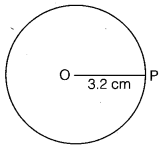
- Keep the steel end of the compasses fixed at the point O and rotate the pencil end at 3.2 cm distance from O till it returns to the starting point P.
Then, the figure so obtained is the required circle.
Ex 14.1 Class 6 Maths Question 2.
With the same centre O, draw two circles of radii 4 cm and 2.5 cm.Solution:
Steps of Construction:- Mark a point 0 on the paper.
- Open the compasses for the radii 4 cm/2.5 cm (tumwise).
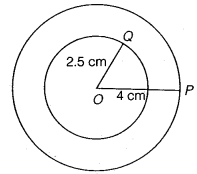
- Keep the steel end of the compasses fixed at the point 0 and rotate the pencil end at 4 cm/2.5 cm (turnwise)distance from O till it returns to their starting points respectively.
The circles obtained are the required circles.
Note: Circles with the same centre are called concentric circles.
Ex 14.1 Class 6 Maths Question 3.
Draw a circle and any two ofits diameters. If you join the ends of these diameters, what is the figure obtained? What figure is obtained if the diameters are perpendicular to each other? How do you check your answer?Solution:
Steps of Construction:- Draw a circle with O as centre of any radius.
- Draw any two diameters AOB and COD.
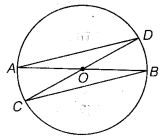
- Join AC, CB, BD and DA.
Clearly, the figure ACBD is a rectangle.
When the diameter AOB and COD are perpendicular to each other:
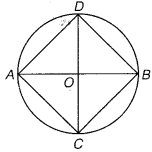
Then, figure obtained on joining AC, CB, BD and DA is a square ACBD.
Ex 14.1 Class 6 Maths Question 4.
Draw any circle and mark points A, B and C such that:(a) A is on the circle.
(b) B is in the interior of the circle.
(c) C is in the exterior of the circle.
Solution:
Steps of Construction: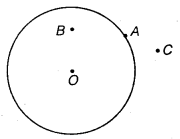
1. Draw a circle with O as centre of any radius.
2. Mark point
(a) A on the circle,
(b) B in the interior of the circle, and
(c) C in the exterior of the circle.
Ex 14.1 Class 6 Maths Question 5.
Let A, B be the centres of two circles of equal radii; draw them so that each one of them passes through the centre of the other. Let them intersect at C and D.Examine whether AB and CD are at right angles.
Solution:
Steps of Construction:- Mark points A and Bona paper such that AB = radii (i.e., 3 cm, say).
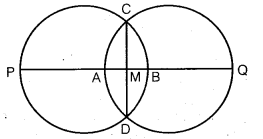
- With A as centre draw a circle of any radius (say, 3 cm).
- With B as centre draw a circle of radius 3 cm as shown.
- Let these circles intersect at C and D.
Clearly, on measuring we find ∠AMC = 90°, so AB ⊥ CD.
NCERT Solutions for Class 6 Maths Chapter 14 Practical Geometry Exercise 14.2
Ex 14.2 Class 6 Maths Question 1.
Draw a line segment of length 7.3 cm, using a ruler.Solution:
Steps of Construction:-
- Mark a point A on the plane of the paper and place the ruler so that zero mark of the ruler is at A.

- Mark a point A on the plane of the paper and place the ruler so that zero mark of the ruler is at A.
- Mark with pencil a point B against the mark on the ruler which indicates 7.3 cm.
- Join points A and B by moving the tip of the pencil against the straight edge of the ruler.
The line segment AB so obtained is the required line segment.
Ex 14.2 Class 6 Maths Question 2.
Construct a line segment of length 5.6 cm using ruler and compasses.Solution:
Steps of Construction:- Mark a point A on the plane of the paper and draw a line, say l, passing through it.

- Place the steel end of the compasses at zero mark on the ruler and open out it such that the pencil end on the mark indicates 5.6 cm.
- Transfer the compasses as it is to the line l so that the steel end is on A.
- With the pencil end make a small stroke on l so as to cut it at B.
- The segment AB so obtained is the required line segment.
Ex 14.2 Class 6 Maths Question 3.
Construct \(\overline { AB } \) of length 7.8 cm. From this, cut off \(\overline { AC } \) of length 4.7 cm. Measure \(\overline { BC } \).Solution:
Steps of Construction:- Draw a line segment AB of length 7.8 cm.

- Using compasses find a point C on the line segment AB so that segment AC = 4.7 cm.
- On measuring BC, we find that BC = 3.1 cm.
Ex 14.2 Class 6 Maths Question 4.
Given \(\overline { AB } \) of length 3.9 cm, construct \(\overline { PQ } \) such that the length of \(\overline { PQ } \) is twice that of \(\overline { AB } \). Verify by measurement.Solution:
Steps of Construction:- Draw a line l and mark a point P on it.

- Using compasses find a point X so that PX(= AB) = 3.9 cm on the line l.
- Using compasses find a point Q so that XQ = 3.9 cm on the line l.
Thus, PQ = PX + XQ = 3.9 cm + 3.9 cm
= 2(3.9 cm) = 2AB.
Ex 14.2 Class 6 Maths Question 5.
Given \(\overline { AB } \) of length 7.3 cm and \(\overline { CD } \) of length 3.4 cm, construct a line segment \(\overline { XY } \) such that the length of \(\overline { XY } \) is equal to the difference between the lengths of \(\overline { AB } \) and \(\overline { CD } \). Verify by measurementSolution:
Steps of Construction: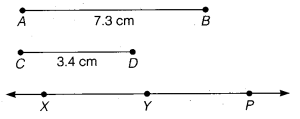
- Draw line segments AB = 7.3 cm and CD = 3.4 cm.
- Draw a line l and mark a point X on it.
- Using compasses find a point P on the line l so that segment XP = segment AB (i.e., 7.3 cm).
- Using compasses find a point Y so that the segment PY = segment CD (i.e., 3.4 cm). The segment XY so obtained is the required segment, because XY = OP -PY – AB -CD.
NCERT Solutions for Class 6 Maths Chapter 14 Practical Geometry Exercise 14.3
Ex 14.3 Class 6 Maths Question 1.
Draw any line segment \(\overline { PQ } \). Without measuring \(\overline { PQ } \), construct a copy of \(\overline { PQ } \).Solution:
Steps of Construction:Let PQ be the given line segment and l be a given line.
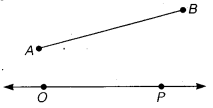
- Mark a point 0 on the line l.
- Open out the compasses and adjust so that the steel end is on A and the pencil end is A on B.
- Transfer the compasses to the line l without disturbing their opening so that the steel end is on 0.
- With the pencil end make a small stroke on the line l to cut it at the point P.
Then, the fine segment OP so obtained = the given line segment AB.
Ex 14.3 Class 6 Maths Question 2.
Given some line segment \(\overline { AB } \), whose length you do not know, construct \(\overline { PQ } \) such that the length of \(\overline { PQ } \) is twice that of \(\overline { AB } \).Solution:
Steps of Construction:Let AB be the given line segment.
- Draw any line l and make a point 0 on it.
- Open out the compasses in such way that the steel end is on A and the pencil end is on B.
- Transfer the compasses without disturbing their opening to the line l so that the steel end is on O.
- With the pencil end make a small stroke on -the line l to cut it at the point P.
- Repeat the steps 3 and 4 with same opening having P as the initial point and Q as the terminal point.
Then, the segment OQ = OP + PQ = AB + AB= 2 AB.
NCERT Solutions for Class 6 Maths Chapter 14 Practical Geometry Exercise 14.4
Ex 14.4 Class 6 Maths Question 1.
Draw any line segment \(\overline { AB } \),. Mark any point M on it. Through M, draw a perpendicular to \(\overline { AB } \),. (use ruler and compasses)Solution:
Steps of Construction: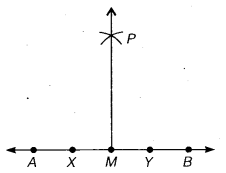
- Draw a line segment AB, and mark any point M on it.
- With centre M and any radius, cut off MX and MY of equal lengths on both sides of M.
- With centre X and any radius > MX, draw an arc.
- With centre Y and the same radius draw another arc, cutting the previously drawn arc at P
- Join MP
Then, the segment PM so obtained is the required perpendicular.
Ex 14.4 Class 6 Maths Question 2.
Draw any line segment \(\overline { PQ } \),. Take any point R not on it. Through R, draw a perpendicular to \(\overline { PQ } \),. (use ruler and set-square)Solution:
Steps of Construction:- Let PQ be the line and R is any point not lying on PQ.
- Place the set-square so that the base AB of the set-square lies exactly on the line PQ.
- Hold the set-square fixed and place a ruler so that its edge position lies along the side AC of the set-square.
- Holding the ruler fixed, slide the set-square along the ruler till the point R coincides with the point B of the set-square.
- Keeping the set-square fixed in this position, draw a line RT along the edge BC of the set-square through R.
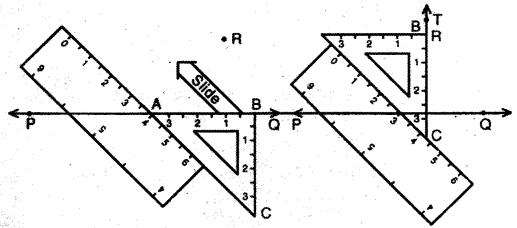
Thus, RT is the required perpendicular line to the line PQ passing through R.
Ex 14.4 Class 6 Maths Question 3.
Draw a line l and a point X on it. Through X, draw a line segment \(\overline { XY } \) perpendicular to l. Now draw a perpendicular to XY at Y. (use ruler and compasses)Solution:
Steps of Construction: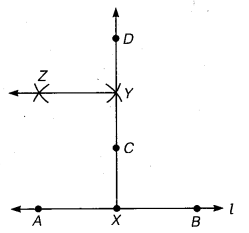
- Draw a line l and mark any point X on it. ,
- With centre X and any radius, cut off XA = XB on both sides of X.
- With centre A and any radius > XA, draw an arc.
- With centre B and the same radius draw another arc, cutting the previously drawn arc at Y.
- Join XY. Then XY is perpendicular to line 1.
- By proceeding as above draw a perpendicular YZ to XY.
NCERT Solutions for Class 6 Maths Chapter 14 Practical Geometry Exercise 14.5
Ex 14.5 Class 6 Maths Question 1.
Draw \(\overline { AB } \) of length 7.3 cm and find its axis of symmetry.Solution:
Steps of Construction:- Draw a line segment AB = 7.3 cm.
- With centre A and radius > \(\frac { 1 }{ 2 } \) AB, draw arcs one on each side of AB.
- With centre B and the same radius as before, draw arcs cutting the previously drawn arcs at C and D respectively.
- Join CD intersecting AB at M. Then M bisects the line segment AB as shown.

The line segment so obtained is the required axis of symmetry.
Ex 14.5 Class 6 Maths Question 2.
Draw a line segment of length 9.5 cm and construct its perpendicular bisector.Solution:
Steps of Construction: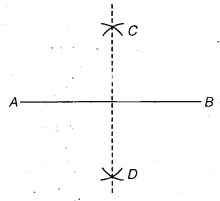
- Draw a line segment AB = 9.5 cm.
- With centre A and radius > \(\frac { 1 }{ 2 } \) AB, draw arcs one on each side of AB. . A
- With centre B and the same radius as before, draw arcs cutting the previously drawn arcs at C and D respectively.
- Join CD. Then the line segment CD is the required perpendicular bisector of AB.
Ex 14.5 Class 6 Maths Question 3.
Draw the perpendicular bisector of \(\overline { XY } \) whose length is 10.3 cm.(a) Take any point P on the bisector drawn. Examine whether PX = PY.
(b) If M is the mid-point of \(\overline { XY } \) , what can you say about the lengths MX and XY?
Solution:
Steps of Construction:- Draw a line segment XY =10.3 cm.
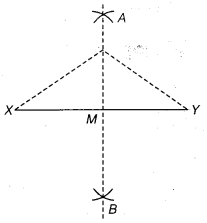
- With centre X and radius > \(\frac { 1 }{ 2 } \) XY, draw arcs one on each side of XY.
- With centre Y and the same radius as before, draw arcs cutting the previously drawn arcs at A and B respectively.
- oin .AB intersecting XY at M. Then, AB is the perpendicular bisector of XY.
(a) Mark any point P on AB, the perpendicular bisector. On measuring, we find that PX = PY.
(b) Since M is the mid-point of the segment XY. Therefore,
MX = \(\frac { 1 }{ 2 } \)XY = \(\frac { 1 }{ 2 } \) x 10.3 cm
= 5.15 cm
Ex 14.5 Class 6 Maths Question 4.
Draw a line segment of length 12.8 cm. Using compasses, divide it into four equal parts. Verify by actual measurement.Solution:
Steps of Construction: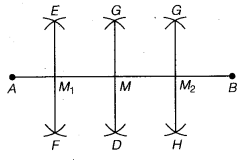
- Draw a line segment AB = 12.8 cm.
- With centre A and radius > \(\frac { 1 }{ 2 } \) AB, draw arcs one on each side of AB.
- With centre B and the same radius as before, draw arcs cutting the previously drawn arcs at C and D respectively.
- Join CD intersecting AB at M.
- Further find the mid-points M1 and M2 of AM and MB respectively proceeding in the same way qs-before.
∴ AM1 = M1M = MM2 = M2B, On measuring, we find that each part = 3.2 cm.
Ex 14.5 Class 6 Maths Question 5.
With \(\overline { PQ } \) of length 6.1 cm as diameter draw a circle.Solution:
Steps of Construction: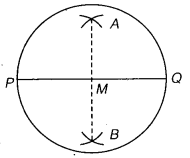
- Draw a line segment PQ = 6.1 cm.
- Bisect the segment PQ by drawing its perpendicular bisector. Let M be its mid-point.
- M as centre and radius = MP draw a circle.
The circle so obtained is the required circle.
Ex 14.5 Class 6 Maths Question 6.
Draw a circle with centre C and radius 3.4 cm. Draw any chord \(\overline { AB } \). Construct the perpendicular bisector of \(\overline { AB } \) and examine if it passes through C.Solution:
Steps of Construction: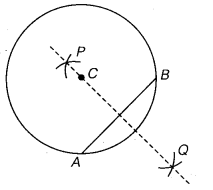
- Mark a point C on the plane of a paper.
- With C as centre and radius 3.4 cm, draw a circle.
- Let AB be any chord to this circle.
- Draw PQ, the perpendicular bisector of chord AB.
Clearly, this perpendicular bisector passes through C, the centre of the circle.
Ex 14.5 Class 6 Maths Question 7.
Repeat Question 6, if AB happens to he a diameter.Solution:
If AB happens to be a diameter then C will be the mid-point of the diameter AB.Ex 14.5 Class 6 Maths Question 8.
Draw a circle of radius 4 cm. Draw any two of its chords. Construct the perpendicular bisectors of these chords. Where do they meet?Solution:
Steps of Construction: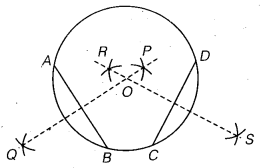
- Mark a point O on the plane of paper.
- With O as centre, draw a circle of radius 4 cm.
- Let AB and CD be any two chords of this circle.
- Draw PQ and RS the perpendicular bisectors of chords AB and CD respectively.
Clearly, these perpendicular bisectors pass through 0, the centre of the circle.
Ex 14.5 Class 6 Maths Question 9.
Draw any angle with vertex O. Take a point A on one of its arms and B on another such that OA = OB. Draw the perpendicular bisectors of \(\overline { OA } \) and \(\overline { OB } \) . Let them meet at P. Is PA = PB?Solution:
Steps of Construction:
- Draw any angle XOY.
- Take a point A on OX and a point B on OY such that OA = OB.
- Draw CD and EF, the perpendicular bisectors of OA and OB respectively. Let them meet at P.
On measuring, we find that PA = PB.
NCERT Solutions for Class 6 Maths Chapter 14 Practical Geometry Exercise 14.6
Ex 14.6 Class 6 Maths Question 1.
Draw ZPOQ of measure 75° and find its line of symmetry.Solution:
Steps of Construction: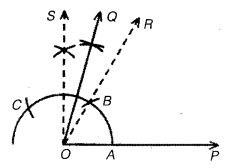
- Draw a ray OP.
- Draw ∠POR = 60° and ∠POS = 90°.
- Draw OQ, the bisector of ∠ROS.
Then,
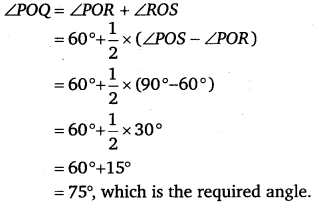
Ex 14.6 Class 6 Maths Question 2.
Draw an angle of measure 147° and construct its bisector.Solution:
Steps of Construction:- Draw a ray OA.
- Place the protractor on OA such that its centre falls on the initial point O and 0 -180 line lies along OA.
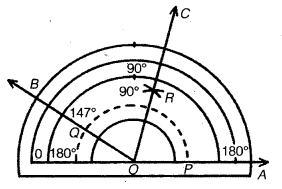
- Mark a point B on the paper against the mark of 147° on the protractor.
- Remove the protractor and draw OB. Then, the ∠AOB so obtained is the required angle such that ZAOB = 147°.
To construct its bisector:
- With centre O and a convenient radius draw an arc cutting sides OA and OB at P and Q respectively.
- With centre P and radius > \(\frac { 1 }{ 2 } \) PQ, draw an arc.
- With centre Q and the same radius, as in the previous step, draw another arc intersecting the arc drawn in the previous step at R.
- Join OR and produce it to form ray OC.
Then, the ∠AOC so obtained is the bisector of ∠AOB.
Ex 14.6 Class 6 Maths Question 3.
Draw a right angle and construct its bisector.Solution:
Steps of Construction: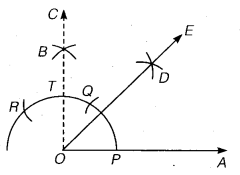
To draw an angle of 90°:
- Draw a ray OA.
- With O as centre and any convenient radius, draw an arc cutting at P.
- With P as centre and same radius, draw an arc cutting the arc of step 2 at Q.
- With Q as centre and the same radius as in steps 2 and 3, draw an arc cutting the arc drawn in step 3 at R.
- With Q as centre and the same radius, draw an arc.
- With R as centre and the same radius, draw an arc cutting the arc drawn in step 5 at B.
To draw its bisector:
- With P as centre and radius > \(\frac { 1 }{ 2 } \) PT, draw an arc in the interior of ∠AOC.
- With T as centre and the same radius, an in step 1, draw another arc intersecting the arc in step 1 at D.
- Join OD and produce it to any point E.
Then, ∠AOE so obtained is the bisector of ∠AOC.
Ex 14.6 Class 6 Maths Question 4.
Draw an angle of measure 153° and divide it into four equal parts.Solution:
Steps of Construction: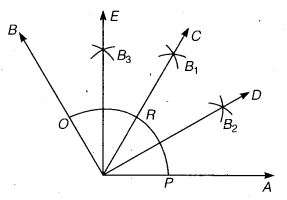
- With the help of the protractor, draw ∠AOB = 153°.
- With centre O and any convenient radius, draw an arc cutting OA and OB at P and Q respectively.
- With centre P and radius > \(\frac { 1 }{ 2 } \) PQ, draw an arc in the interior of ∠AOB.
- With centre Q and the same radius, as in step 3, draw another arc intersecting the arc in step 3 at B1.
- Join OB1 and produce it to any point C.
Then, ∠AOC = \(\frac { 1 }{ 2 } \) x ∠AOB i.e., bisector of ∠AOB. - Draw OD, the bisector of ∠AOC. Then ∠AOD = ∠DOC.
- Draw OE, the bisector of ∠COB. Then, ∠COE = ∠COB.
Combining these results, we have
∠AOD = ∠DOC = ∠COE = ∠EOB.
Thus, ∠AOB is divided into four equal parts by the rays OD,OC and OE.
Ex 14.6 Class 6 Maths Question 5.
Construct with ruler and compasses, angles of following measures:(a) 60°
(b) 30°
(c) 90°
(d) 45°
(f) 135°
Solution:
(a) Steps of Construction: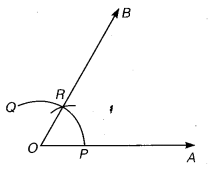
- Draw a ray OA.
- With centre O and any radius, draw an arc PQ with the help of compasses, cutting the ray at P.
- With centre P and the same radius draw an arc cutting the arc PQ at R.
- Join OR and produce it to obtain ray OB.
Then, ∠AOB so obtained is of 60°.
(b) Steps of Construction:
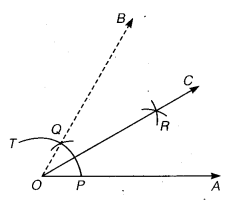
- Draw a ray OA.
- With centre O any radius draw an arc PT with the help of compasses, cutting ray OA at P.
- With centre P and the same radius draw an arc cutting the arc PT at Q.
- Join OQ and produce it to obtain ray OB.
Then, ∠AOB = 60°. - With centre P and radius > \(\frac { 1 }{ 2 } \) PQ, draw an arc in the interior of ∠AOB.
- With centre Q and the same radius, as in step 5, draw another arc intersecting the arc in step 5 at R.
- Join OR and produce it on any point C.
Then, ∠AOC = 30°
(c) Step of Construction:
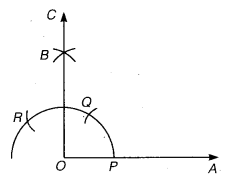
- Draw a ray OA.
- With O as centre and any convenient radius, draw an arc cutting at P.
- With P as centre and same radius, draw an arc cutting the arc of step 2 at Q.
- With Q as centre and the same radius as in steps 2 and 3, draw an arc cutting the arc drawn in step 3 at R.
- With Q as centre and the same radius, draw an arc.
- With R as centre and the same radius, draw an arc cutting the arc drawn in step 5 at B.
- Join O to B and produce it to any point C.
Then, ∠AOC =90°
(d) Steps of Construction:
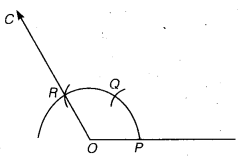
- Draw a ray OA.
- With O as centre and any convenient radius, draw an arc cutting OA at P.
- With P as centre and the same radius draw an arc cutting the first arc at Q.
- With Q as centre and the same radius, draw an cutting the arc drawn in step 2 at R.
- Join AR and produce it to any point C.
Then, ∠AOC so obtained is of 120°.
(e) Steps of Construction:
- Draw ∠AOC = 90° by following the steps given in part (iii) above,
- Draw OE, the bisector of ∠AOC.
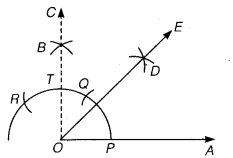
Then, ∠AOD so obtained is the required angle of 45°.
(f) Steps of Construction:

- Draw ∠AOC = 120°
∠AOB =150°. - Draw OD, bisector of ∠COB.
Then,

Or
Steps of Construction:

- Draw a line AB and mark a point O on it.
- With centre O and any convenient radius draw a semi-circle cutting OA and OB at P and Q respectively.
- With Q as centre and same radius, draw an arc cutting the semi-circle as R.
- With R as centre and same radius, draw an arc cutting the semi-circle of step 2 at S.
- With R as centre and same radius draw an arc.
- With S as centre and same radius draw an arc cutting the arc drawn in step 5 at T. Join OT and produce it to D such that ∠BOD – ∠AOD = 90°.
- Draw OE, the bisector of ∠AOD.

Ex 14.6 Class 6 Maths Question 6.
Draw an angle of measure 45° and bisect it.Solution:
Steps of Construction:- Draw ∠AOB = 90° by the steps given in question 5 (c).
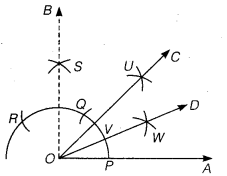
- Draw OC, the bisector of ∠AOB. Then, ∠AOC = 45°.
- Draw OD, the bisector of ∠AOC. Then, ∠AOD = ∠DOC.
Ex 14.6 Class 6 Maths Question 7.
Draw an angle of measure 135° and bisect it.Solution:
Steps of Construction:- Draw ∠EOB = 135° by the steps given in question 5 (f).
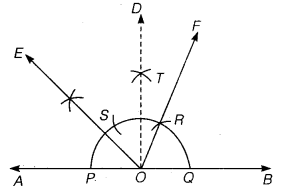
- Draw OF, the bisector of ∠EOB.
Then, ∠BOF = ∠FOE.
Ex 14.6 Class 6 Maths Question 8.
Draw an angle of 70°. Make a copy of it using only a straight edge and compasses.Solution:
Steps of Construction:- Draw an angle 70° with protractor, i. e. ∠POQ = 70°
- Draw a ray \(\overline { AB } \)
- Place the compasses at O and draw an arc to cut the ray of ∠POQ at I and M.
- Use the same compasses, setting to draw an arc with A as centre, cutting AB at X.
- Set your compasses setting to the length LM with the same radius.
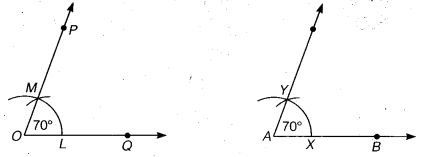
- Place the compasses pointer at X and draw the arc to cut the arc drawn earlier at Y.
- Join A7.
Thus, ∠YAX =70°
Ex 14.6 Class 6 Maths Question 9.
Draw an angle of 40° copy its supplementary angle.Solution:
Steps of construction:- Draw an angle of 40° with the help of protractor, naming ∠ AOB.
- Draw a line PQ.

- Take any point M on PQ.
- Place the compasses at O and draw an arc to cut the rays of ∠ AOB at L and N.
- Use the same compasses setting to draw an arc O as centre, cutting MQ at X.
- Place the compasses at X and draw the arc to cut the arc drawn earlier Y.
- Join MY.
Thus, ∠QMY = 40° and ∠PMY is supplementary of it.
NCERT Class 6 Maths
Class 6 Maths Chapters | Maths Class 6 Chapter 14
NCERT Solutions for Class 6 Maths
NCERT Solutions of Maths Class 6 Chapter-wise
Chapter-wise NCERT Solutions for Class 6 Maths
-
NCERT Solutions For Class 6 Maths Chapter 1 Knowing Our Numbers
NCERT Solutions For Class 6 Maths Chapter 2 Whole Numbers
NCERT Solutions For Class 6 Maths Chapter 3 Playing With Numbers
NCERT Solutions For Class 6 Maths Chapter 4 Basic Geometrical Ideas
NCERT Solutions For Class 6 Maths Chapter 5 Understanding Elementary Shape
NCERT Solutions For Class 6 Maths Chapter 6 Integers
NCERT Solutions For Class 6 Maths Chapter 7 Fractions
NCERT Solutions For Class 6 Maths Chapter 8 Decimals
NCERT Solutions For Class 6 Maths Chapter 9 Data Handling
NCERT Solutions For Class 6 Maths Chapter 10 Mensuration
NCERT Solutions For Class 6 Maths Chapter 11 Algebra
NCERT Solutions For Class 6 Maths Chapter 12 Ratio and Proportion
NCERT Solutions For Class 6 Maths Chapter 13 Symmetry
NCERT Solutions For Class 6 Maths Chapter 14 Practical Geometry
NCERT Solutions for Class 6 to 12
-
NCERT Solutions for Class 6 All Subjects
NCERT Solutions for Class 7 All Subjects
NCERT Solutions for Class 8 All Subjects
NCERT Solutions for Class 9 All Subjects
NCERT Solutions for Class 10 All Subjects
NCERT Solutions for Class 11 All Subjects
NCERT Solutions for Class 12 All Subjects

Post a Comment
इस पेज / वेबसाइट की त्रुटियों / गलतियों को यहाँ दर्ज कीजिये
(Errors/mistakes on this page/website enter here)